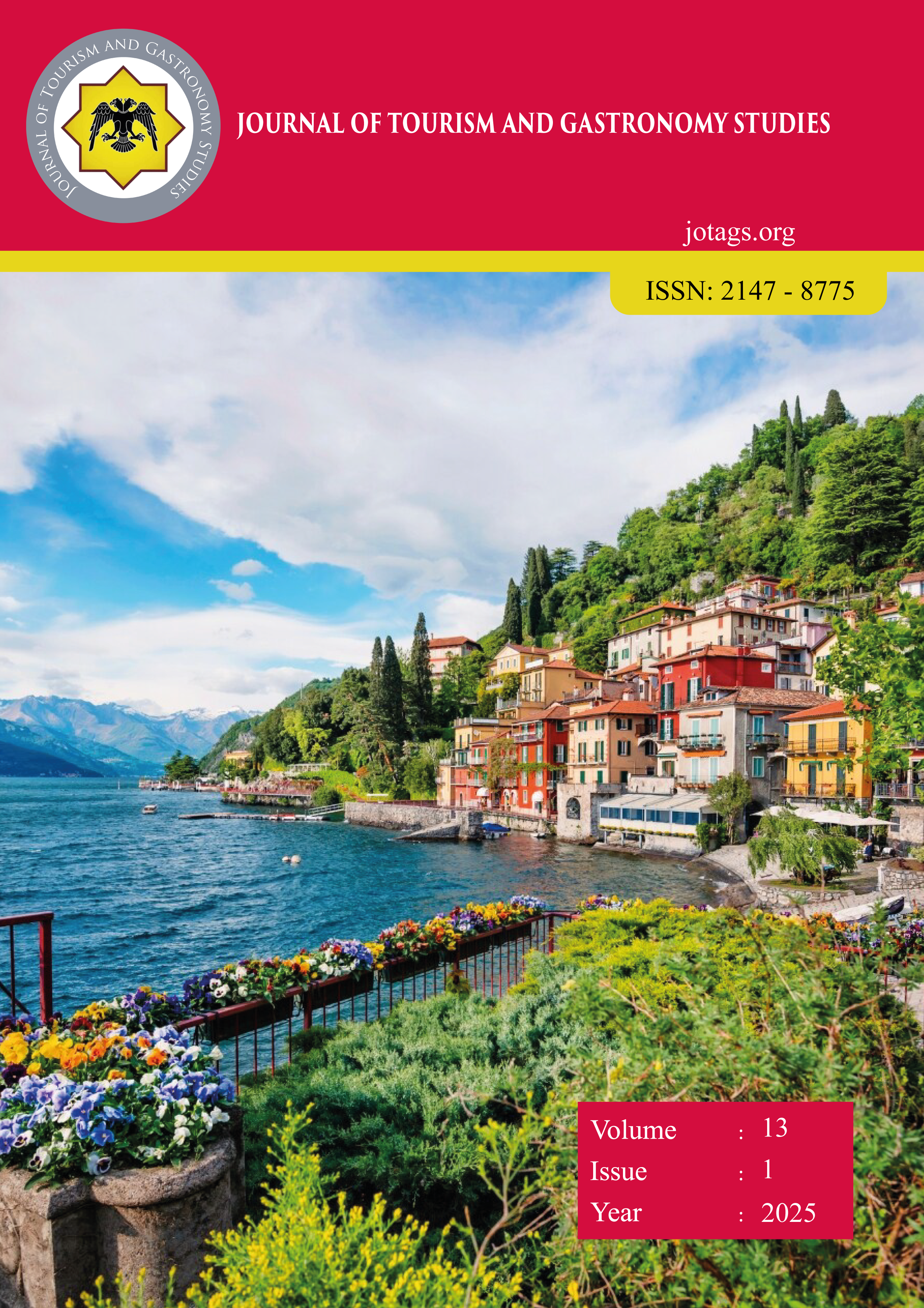Yiyecek İçecek İşletmelerinin Kültürel Değeri Salaş Mekânlar Üzerine Kavramsal Bir Değerlendirme (Cultural Value of Food and Beverage Establishments A Conceptual Evaluation of Shabby Places)
DOI:
https://doi.org/10.21325/jotags.2025.1592Keywords:
Restaurant, Food culture, Shabby spaceAbstract
This study aims to provide a comprehensive answer to the question of what a ‘shabby place’ is by conceptually evaluating the ‘shabby place’ as a cultural value of food and drink establishments. To this end, national and international literature has been extensively reviewed. It was found that shabby places are generally known for their modest decor and affordable menus, offering a friendly and cosy environment. They were found to be an important part of local culture and social relations. In addition to the conceptual evaluation of shabby places, the study found that they have the potential to protect cultural heritage, strengthen the sense of community and increase social interaction. The findings of this study, supported by the literature, highlight the sustainability and cultural importance of these enterprises. It is hoped that the findings of the study will inform future research in the food and beverage sector.
References
Adanur, E. (2019). Gastronomi Turizmi Üzerine Bir Çalışma: Gaziantep Örneği. Yüksek Lisans Tezi. Gaziantep Üniversitesi, Sosyal Bilimler Enstitüsü, Gaziantep.
Akgündüz, Y., Akdağ, G., & Metin, U. (2019). Restoran seçimi kriterlerinin müşteri sadakatine etkisi: Mersin’de bir araştırma. Anadolu Üniversitesi Sosyal Bilimler Dergisi, 19(4), 1-14.
Aksu, M., Korkmaz, H. & Sünnetçioğlu, S. (2016). Yiyecek ve İçecek İşletmelerindeki Hizmet Kalitesinin Müşteri Memnuniyeti Üzerinde Etkisi: Bozcaada’da Dineserv Modeliyle Bir Araştırma, Balıkesir Üniversitesi Sosyal Bilimler Enstitüsü Dergisi, 19(35), 1-18.
Albayrak, A. (2014). Müşterilerin restoran seçimlerini etkileyen faktörler: İstanbul örneği. Anatolia: Turizm Araştırmaları Dergisi, 25(2), 190-201.
Arıker, Ç. (2012). Tüketicilerin restoran seçiminde kullandıkları seçim kriterleri ile demografik özellikleri arasındaki ilişki. Öneri Dergisi, 10(38), 11-31.
Ar, M. (2021). Mekân, yer ve yersizlik kavramları üzerine bir inceleme, Şehir ve Medeniyet Dergisi, 7(14), 8-25.
Beardsworth A, Keil T (1997). Sociology on the Menu. Routledge: London.
Becan, C., & Coşkun, F. İ. (2021). Gıda takviyesi kullanımına yönelik farkındalık oluşturmada etkileyici iletişimin bir aktörü olarak dijital etki liderlerinin rolü: Keşifsel Bir Araştırma, Karadeniz Teknik Üniversitesi İletişim Araştırmaları Dergisi, 11(2), 84-121.
Bushara, M. A., Abdou, A. H., Hassan, T. H., Sobaih, A. E. E., Albohnayh, A. S. M., Alshammari, W. G., Aldoreeb, M., Elsaed, A. A. & Elsaied, M. A. (2023). Power of social media marketing: how perceived value mediates the impact on restaurant followers’ purchase intention, willingness to pay a premium price, and e-WoM?. Sustainability, 15(6), 5331.
Camillo, A. A. (2021). Strategic International Restaurant Development: From Concept to Production. Business Science Reference. 1st ed. Pennsylvania: IGI Global.
Chehab, O., Bouzari, M. & Ilkhanizadeh, S. (2023). Job Motivation mediating the effects of standardization on restaurant frontline employees’ job outcomes: Evidence from Lebanon, Journal of Quality Assurance in Hospitality & Tourism, 24:6, 836-858, DOI: 10.1080/1528008X.2022.2089944
Cömert, M., & Özata, E. (2016). Tüketicilerin yöresel restoranları tercih etme nedenleri ve Karadeniz mutfağı örneği. Journal of International Social Research, 9(42).
Daştan, N. (2023). Mekânın Folkloru: Ticari işletmelerin duvar dekorasyonunda kültürel unsurların yeri (Erzurum ili örneği), Dil ve Edebiyat Araştırmaları, (27), 79-101. DOI: 10.30767/ diledeara.1222485
Demir, G. (2017). Oldenburg’un üçüncü mekân paradigması bağlamında kütüphane mekânının sorgulanması, Bilgi Dünyası, 18(2), 195-223. doi: 10.15612/BD.2017.628
Demirtaş, N. & Pektaş, K. (2020). UNESCO yaratıcı gastronomi şehri Hatay'ın yerel gastronomi işletmecilerinin bakış açısıyla farkındalık düzeyinin incelenmesi, Türk Turizm Araştırmaları Dergisi, 4(3): 2724-2745.
Demirtaş, N., Demir, E. & Pektaş, K. (2022). Investigation of the level of usage of traditional fruit dishes in Gaziantep Cuisine in restaurant menus. Journal of Tourism & Gastronomy Studies, 10(3), 1924-1936. DOI: https://doi.org/10.21325/jotags.2022.1074
Er, C. (2019). Batı ve Türkiye Tiyatrosunda Mekân Dramaturjisi, Yüksek Lisans Tezi. İstanbul Üniversitesi, Sosyal Bilimler Enstitüsü, Tiyatro Eleştirmenliği ve Dramaturji Ana Bilim Dalı, İstanbul.
Erol, G., & Alaşhan, A. (2020). Özel günlerdeki geleneksel yemek anlayışının gastronomi açısından değerlendirilmesi: Ürgüp örneği. Turkish Studies-Social Sciences, 15(8).
Eryılmaz, G., Demir, E. & Pektaş, K. (2019). Silifke yöresel mutfak kültürü unsuru olan “Silifke Yoğurdu”nun gastronomi turizmi açısından değerlendirilmesi, 4. Uluslararası Gastronomi Turizmi Araştırmaları Kongresi, 19-21 Eylül 2019, ss. 189-197, Nevşehir.
Etimolojik Türkçe (2024). https://www.etimolojiturkce.com/kelime/sala%C5%9F Erişim Tarihi: 09.07.2024.
Golden Crown FSDC, (2020). Yiyecek İçecek İşletmelerinin Sınıflandırılması. Erişim Adresi: https://gcfsdc.com/yiyecek-icecek-isletmelerinin-siniflandirilmasi/ Erişim Tarihi: 23.07.2024.
Gün, S., ve Aksu, K. (2023). Netnografi ile müşteri deneyimlerinin incelenmesi: Siirt büryanı örneği, Atlas Sosyal Bilimler Dergisi, 1(14), 1-19.
Harmandar, S. (2020). 19. Yüzyılda İstanbul’da değişen eğlence anlayışı ve yeni eğlence mekânları, ETÜT Dergisi, 1(1), 114-117. Doi 10.52003/etut.2021.6
Hasdedeoğlu, M. O. (2023). Reşat Nuri’nin Anadolu Notları’nda kamusal mekânlar ve toplumsal ilişkiler, Uluslararası Halkbilimi Araştırmaları Dergisi, 6(1), 84-101.
International Wine Spirits Academy (IWSA), (2024, Temmuz). Meyhane nedir? https://www.iwsa.com.tr/fermente-distile/meyhane-nedir.html Erişim Tarihi: 25.07.2024.
Kaçan, U. (2023). Örgütsel Kültür ve İletişim Bağlamında “Lüks Restoran” Konsepti. Aydın Gastronomy, 7(2), 325-347.
Kenar, G. (2023). Karavan turistlerinin motivasyonuna etki eden unsurların belirlenmesi, Güncel Turizm Araştırmaları Dergisi, 7(2), 445-466. https://doi.org/10.32572/guntad.1243815
Kim, W. G., Lee, Y. K., & Yoo, Y. J. (2006). Predictors of relationship quality and relationship outcomes in luxury restaurants. Journal of Hospitality & Tourism Research, 30(2), 143-169.
Kowalczyk, A., Derek, M. (2020). Gastronomy and urban space: Changes and challenges in geographical perspective, Kentsel Kitap Serisi. Cham. DOI: 10.1007/978-3-030-34492-4.
Köksal, G., & Yavuz, C. (2023). Müşterilerin Zincir Restoran Seçimini Etkileyen Faktörler. Kent Akademisi, 16(4), 2716-2733.
Lokantacılık Meslek Kılavuzu (2021). Lokantacılık Tanımı. Ted Matbaacılık: Ankara.
Manuel, C. S., Robbins, G., Slater, J., Walker, D. K., Parker, A. & Arbogast, J. W. (2023). Hand hygiene product use by food employees in casual dining and quick-service restaurants, Journal of Food Protection, 86(2), 100004.
Montagne, P. (1977). The New Larousse Gastronomique. Crown Publishing, New York.
Norris, C., Taylor Jr, S. & Taylor, D. C. (2024). Just the tip: Exploring the tipped restaurant employee perspective, International Hospitality Review, 38(2), 221-238.
Özdemir, Y. (2006). Sait Faik Abasıyanık’ın Eserlerinde Mekân Olarak İstanbul, Yüksek Lisans Tezi. İstanbul Üniversitesi Sosyal Bilimler Enstitüsü İstanbul.
Özeltürkay, E. Y. & Karaömerlioğlu, D. (2018). Teknoloji çocuklarının akıllı perakendecilik uygulamalarına ilişkin deneyim ve beklentilerini belirlemeye yönelik keşifsel bir çalışma, Gençlik Araştırmaları Dergisi, 6(15), 135-166.
Park, K. & Ha, J. (2023) Examination of web-accessibility in the restaurant ındustry, Journal of Foodservice Business Research, 26:6, 823-842, DOI: 10.1080/15378020.2022.205140
Prayag, G., Hosany, S., Taheri, B., & Ekiz, E. H. (2019). Antecedents and Outcomes of relationship quality in casual dining restaurants: The mediating effects of relationship quality and moderating roles of gender. International Journal of Contemporary Hospitality Management, 31(2), 575-593.
Richards, K. (2002). Retail and Restaurant Spaces: an İnternational Portfolio of 41 Designers. Rockport publishers.
Ryu, K., & Jang, S. S. (2007). The effect of Environmental Perceptions on Behavioral Intentions Through Emotions: The Case of Upscale Restaurants. Journal of Hospitality & Tourism Research, 31(1), 56-72.
Sha’ari, N. S. M., Sazali, U. S., Zolkipli, A. T., Vargas, R. Q. & Shafie, F. A. (2023). Environmental assessment of casual dining restaurants in urban and suburban areas of peninsular Malaysia during the covid-19 pandemic, Environmental Monitoring and Assessment, 195(2), 346.
Souki, G. Q., de Oliveira, A. S., Guerreiro, M. M. M., da Costa Mendes, J. & Moura, L. R. C. (2022). Do Memorable Restaurant Experiences Affect eWOM? The moderating effect of consumers' behavioural engagement on social networking sites. The TQM Journal, 35(8), 2255-2281.
Sung, K. S. & Lee, S. (2023). Interactive CSR campaign and symbolic brand benefits: A moderated mediation model of brand trust and self-congruity in the restaurant ındustry, International Journal of Contemporary Hospitality Management, 35(12), 4535-4554.
Şahin, A. (2021) Michelın Restoranlarında Müşteri Talebi ve Deneyimi Üzerine Bir Araştırma, Yüksek Lisans Tezi. Aydın Adnan Menderes Üniversitesi Sosyal Bilimler Enstitüsü Aydın.
Şahin, Z. S. (2019). Törensel yemeklerin gastronomik coğrafi işaretli ürünler olarak kullanımı: İskilip dolması örneği, In Internatıonal West Asıa Congress of Tourısm (Iwact ‘19) The Book of Proceedings.
Şenel, P. ve Yılmaz, H. (2020). Bir restoran türü olarak konsept restoranlar, Journal of Tourism Leisure and Hospitality, 2(1), 22-28.
Şenyurt, O. (2023). Geç Osmanlı’da tiyatroya tepkilerin gölgesinde Şehzadebaşı’nda Kâgir tiyatro binalarının inşa süreci, Uluslararası Tarih Araştırmaları Dergisi, 7(1), 27-56.
Şeyhanlıoğlu, H. Ö., Hazarhun, E., Arıca, R. & Durdu, K. M. (2023). Yiyecek-içecek işletmelerine yönelik trıpadvısor’da yer alan paylaşımların incelenmesi: Batman örneği, Visionary E-Journal/Vizyoner Dergisi, 14(39), 877-898.
Tatarlar, C. D. & Çangarlı, B. G. (2018). İntikam mı affetme mi? Örgütsel yaşamda çok bilinmeyenli bir denklem, Ege Academic Review, 18(4), 591-603.
TDK (2024). Sözcükler / Lokanta. Erişim Adresi: https://sozluk.gov.tr/?q=lokanta&aranan= Erişim Tarihi: 25.07.2024.
TDK (2024). Sözcükler / Mekân. Erişim Adresi: https://sozluk.gov.tr/?q=MEKAN&aranan= Erişim Tarihi: 09.07.2024.
TDK (2024). Sözcükler / Salaş. Erişim Adresi: https://sozluk.gov.tr/ Erişim Tarihi: 09.07.2024.
Toy, B. (2023). Türk Resminde Deniz Hamamları, Yüksek Lisans Tezi. Bursa Uludağ Üniversitesi Sosyal Bilimler Enstitüsü Bursa.
Türkay, O., & Atasoy, B. (2020). Restoran seçiminde kişiliğin rolü: Sakarya örneği. Selçuk Üniversitesi Sosyal Bilimler Meslek Yüksekokulu Dergisi, 23(2), 401-412. https://doi.org/10.29249/selcuksbmyd.687053
Türkiye Turizm Ansiklopedisi (2024). Casual Restoran. Erişim Adresi: https://turkiyeturizmansiklopedisi.com/casualrestoran#:~:text=G%C3%BCndelik%20ortamda%20makul%20fiyatl%C4%B1%20yiyecek,restoranlar%C4%B1%20tan%C4%B1mlamak%20i%C3%A7in%20kullan%C4%B1lan%20kavram. Erişim Tarihi: 11.27.2024.
Wang, Y. C. & Papastathopoulos, A. (2023). Cross-segment validation of customer support for AI-based service robots at luxury, fine-dining, casual, and quick-service restaurants, International Journal of Contemporary Hospitality Management, 36(6), 1744-1765.
Wilson, E. (2016). Matching up: Producing Proximal Service in a Los Angeles Restaurant, in Research in the Sociology of Work (pp. 99-124). Emerald Group Publishing Limited. https://doi.org/10.1108/S0277-283320160000029015
Xing, Z. (2023). The Impact of Service Technology Attributes on Customers' Behavioral Intentions in Casual Dining Restaurants, Master of Science. Faculty of California State Polytechnic University, Pomona.
Yalvaç, N. S. (2016). The Dynamıcs of Dıstınctıon and Cultural Omnıvorousness in the Culınary Fıeld of Turkey, Master‘s Thesis. Mıddle East Technıcal Unıversıty, Institute of Social Sciences, Ankara.
Zapata-Cuervo, N., Montes-Guerra, M. I. & Jeong, M. (2023). How do Restaurants Respond to the COVID-19 Pandemic? Lessons From Colombian Restauranteurs and Their Survival Strategies. Journal of Foodservice Business Research, 26(2), 186-207.
Zukin, S. (2014). Restaurants as “Post Racial” Spaces Soul Food and Symbolic Eviction in Bedford Stuyvesant (Brooklyn), Ethnologie Francaise, 44(1), 135-147.
Downloads
Published
How to Cite
Issue
Section
License
Copyright (c) 2025 Journal of Tourism & Gastronomy Studies

This work is licensed under a Creative Commons Attribution-NonCommercial 4.0 International License.








